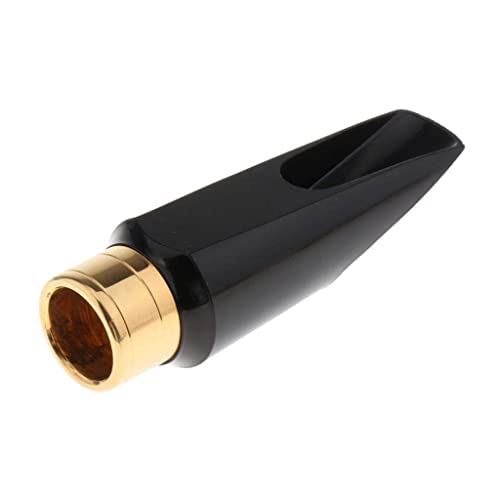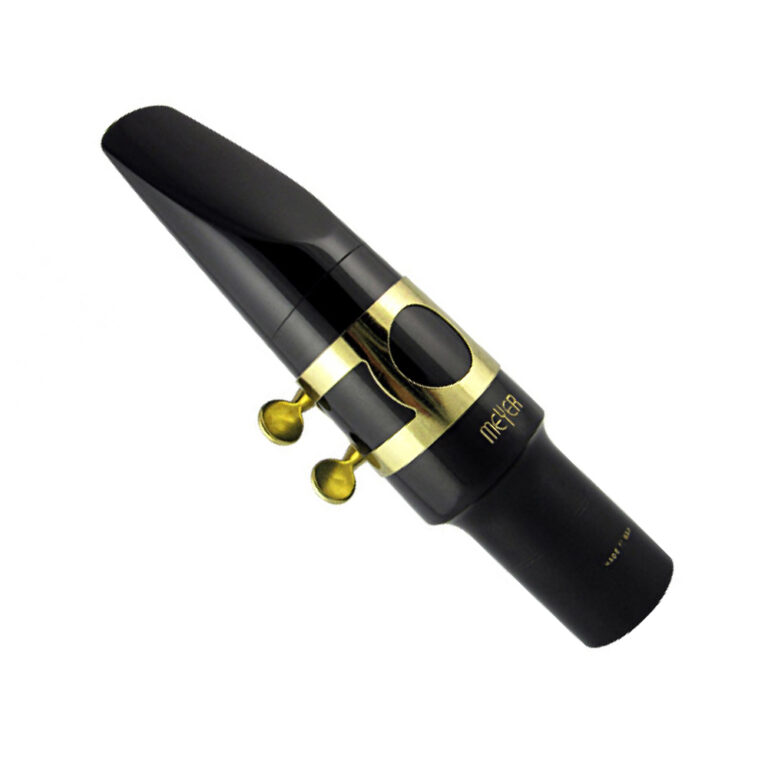Saxophones have different components that make the instrument produce sound, and saxophone mouthpiece is a key part of its overall performance.
Depending on the type of music you play or whether you are an amateur or a professional player, choosing the best mouthpiece for you is essential.
Also, since you can’t try it out before choosing the one that fits you, you will have to rely on its features and reviews to make the right decision.
Here’s a saxophone mouthpiece guide with what you need to take into consideration when buying a saxophone mouthpiece that aligns with your wants and needs perfectly.
What is a Saxophone Mouthpiece?
On instruments such as the clarinet and saxophone, mouthpieces are the part to which the reed is attached and are responsible for providing an opening for air to enter the instrument to be transformed into sound.
The decision on what the best saxophone mouthpieces are depends on personal preference and the type of music you aim to play.
What is the function of a Saxophone Mouthpiece?
Saxophone mouthpieces contain a reed (the piece where the player places his/her lips) which vibrates with the player’s breath and in turn causes the column of air inside the instrument to vibrate as well, producing music.
The way the mouthpiece’s interior is shaped affects the sound. For example, mouthpieces with small or square chambers produce different tonalities than those with a rounded chamber.
A common misconception is that the tip opening affects the tone when, in reality, the tone is affected by the design of the mouthpiece’s chamber.
Build Breakdown
We already established what the reed is, but the saxophone mouthpiece has other components as well and let’s talk about the more important ones.
First, we have the facing, which is where the mouthpiece meets the reed and correlates to the opening of the tip and the chamber refers to the internal shape of the mouthpiece.
The sidewalls are the internal walls of the mouthpiece under the side rails leading into the chamber and have a similar effect on the sound’s volume as the chamber.
Depending on how they’re built it will direct the airflow in specific ways.
The baffle is located behind the tip rail and opposite the vibrating reed and it defines how much “edge” or “bite” the mouthpiece features.
For bright sounds that are well projected, choose a mouthpiece with a higher baffle and for warm and mellow sounds choose a lower baffle.

The Types of Saxophone Mouthpieces (according to style of music)
There are hundreds of styles and plenty of manufacturers of saxophone mouthpieces to choose from.
Your decision should be based on the music genre you play and not so much on whether you are a student, intermediate or professional player.
Each saxophone mouthpiece is designed to maximize your sound, different music genres have specific requirements and skill sets.
Let’s explore the differences between the classical saxophone mouthpiece and the jazz mouthpiece to enlighten you while choosing the one that fits you.
Classical Mouthpiece
Classic music usually is soft, melodic, and comforting.
A classical saxophone mouthpiece has a medium length facing curve and a medium-to-medium close tip opening. It is usually made of ebonite, an organic polymer also known as vulcanized rubber or hard rubber.
The chambers are open, with low baffles and the tip openings are smaller for harder reed use.
The combination of the material, low baffle, open chamber, and tip openings allow you to produce the darker and richer sounds characteristic of classical music and could be used by students and experienced players alike.

Jazz Mouthpiece
Also made of ebonite or metal, the jazz mouthpiece has a big tip opening, high baffle and large chamber which translates into more flexibility and more robust tones.
Playing jazz music with a saxophone, one of the main instruments in this music genre, is more demanding than playing classical music and requires more control while playing, as well as greater force on the embouchure and air.
This type of mouthpiece can be tricky to dominate, so if you are starting in the jazz scene, it may be better to use a concert band mouthpiece with jazz sound until you gain the necessary skills and control to play with the jazz mouthpiece.

Tip variety
A Saxophone mouthpiece can come with different levels of openings depending on the style of playing and level of experience with such an instrument.
The tip opening is the distance between the reed and the mouthpiece tip and to easily identify it simply notice that the smaller the tip size the narrower the opening will be.
There are pros and cons on each level of tip opening, but in the end, it will depend on what you’re comfortable with.
For example, tips sized 3-4 are easier to play with and provide even intonation, but if you blow air too hard the reed can close and it’s harder to bend notes and make inflections.
Tips sized 5-7 allow you to make inflections and have very good intonation but it requires more air force than tips sized 3-4.
Finally, tips sized 8-10 produce big sound and the step baffle sounds better, but you need to blow hard into it, and it requires more control to keep in tune.
Materials
Nowadays, when buying a saxophone mouthpiece, you will notice that the most common is the rubber mouthpiece, but you can find options in different materials as well.
Usually used by students, a plastic saxophone mouthpiece is very durable and low priced but produces bright sounds that can be a challenge to dominate.
A wooden mouthpiece is not as common but produces the warmest tone of all the materials already listed.
However, it has less sound projection and can be unstable, compared to ebonite or plastic.
Crystal mouthpieces have strong projection and bright sound, but the downside is its fragility.
Also, we can find two types of metal saxophone mouthpieces: Metal-Plated Brass and Stainless Steel.
Plated Brass is very versatile and the most common is gold-plating. Stainless Steel mouthpieces produce extremely bright sounds and have the most projection overall.
What to Look After When Buying a New Mouthpiece
Although choosing the correct saxophone mouthpiece for you depends mostly on your preferences, there’s one detail that you need to pay close attention to. That is the facing curve where the reed lies.
When the reed opens and closes it bends along the facing curve so if there are issues with the curve the reed won’t be able to vibrate correctly.
This will add resistance and sometimes squeak or make the low or higher end suffer.
It could be so grave that sometimes it could render the mouthpiece useless.
Differences between a good and a bad facing curve are miniscule but have a great effect on the playability.
In other words, if the facing is not good, keep looking because it’s worthless.
Unfortunately, issues with the facing curve are very common so you should have it measured before choosing one.
You can also do a visual check of the mouthpiece to check for damages and chips, as well as lack of symmetry in the tip and side rails, scratches, or other obvious damages.


Which Mouthpiece is Good for Beginners
Just because a student saxophone comes with a mouthpiece it doesn’t necessarily mean that it is the best option for that particular player.
Sometimes choosing a professional-level saxophone mouthpiece will improve playability and give better response, tuning, articulation and tonal control to the beginner as well.
As a sax player, or future student, you should take into consideration the musical genre you wish to play and your expectations.
Also, analyze the tip sizes and its pros and cons because, as we said earlier, different sizes will require a different set of skills and dominance, and maybe as a beginner you may struggle with some of those specifications.
Each player is different and there’s a whole universe of combinations possible; that’s the reason there are so many mouthpieces to choose from. Maybe what works for your fellow sax player could be a total bust for you.
Top 5 Companies Producing Sax Mouthpieces
If you’re looking for well balanced quality sound, whether you are a beginner or an experienced sax player, Vandoren mouthpieces are the answer.
Designed to be more responsive and to give accurate articulation and control over the ranges’ dynamic and intonation, Vandoren is a brand known by musicians for their high quality and variety which makes it one of the best on the market.
Another top brand is Selmer Paris and its different series. Made from hard rubber, the flexible mouthpiece shows great response over all registers making it a great choice for either classical or studio music.
It’s renowned by musicians because of its durable and strong design, as well as how much it makes music sound grander and better.
However, if you are looking for durability above all, then the Meyer Alto Saxophone Mouthpiece is for you because it features the right balance between durability and rich sounds while being easy to use and shows great response from low to altissimo notes.
If versatility is what you need, Claude Lakey sax mouthpieces can be used on multiple sax brands and produces clear sounds on alto saxophones. It has an elegant, sturdy, and compact design and it’s made from ebonite.
Finally, if your decision is heavily influenced by your budget, Yamaha mouthpieces offer both quality and accessibility.
Made from plastic, it is suitable for both beginners and skilled players while maintaining clear and balanced tones.
You can play any musical style with this mouthpiece and still maintain quality. The downside is that it is not the most durable.
Final Thoughts
No matter what your preferences, budget and skill level is, you need to understand that the mouthpiece’s design will ultimately affect its sound. So, pay close attention to details when choosing a saxophone mouthpiece;
Have a specialist measure its components to ensure it has no issues that could impair it and make an educated decision, because at the end of the day the mouthpiece you choose should make your life easier, not complicate things.
Additionally, Make sure to check out our article on saxophone reeds that goes in combination with mouthpieces to ensure the quality sound that you’re aiming for.

